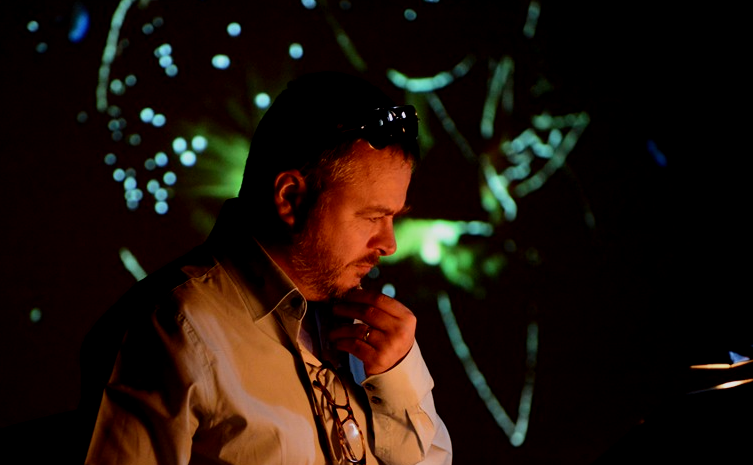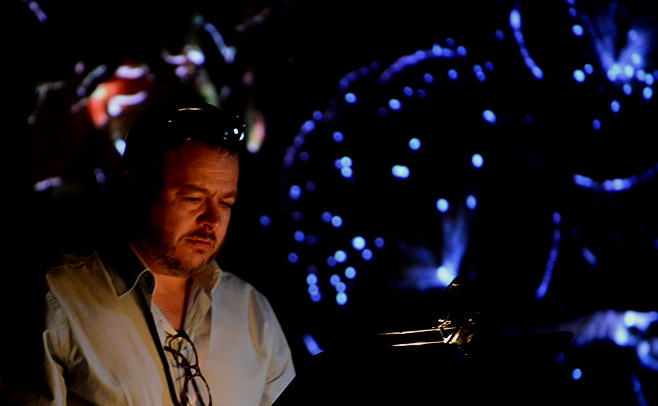| SONNTAG
- 15 Mai 2016 - 20h30 - Schloss Leuk
JOHN CAGE - VARIATIONS II
PROGRAMM John Cage (1912-92)
KOMMENTAR Variations II (1961) by John Cage (1912-92) is a series (I-VIII) of works by American composer John Cage. Some of the pieces in the series are seminal examples of indeterminate music, others are happenings: performance pieces executed according to the score. Variations II (1961) is intended "for any number of players and any sound producing means." The score consists of eleven transparent sheets: six lines and five points. The mechanism is the same as in Variations I: perpendiculars are dropped from points to lines to determine sound characteristics, except that the list of characteristics is different: frequency, amplitude, timbre, etc. Variations II represents the greatest degree of abstraction of a compositional and notational model that Cage developed over the period from 1958 to 1961. The basic mechanism is very simple: interpreting the distance from a point to a line as a measurement of a musical parameter. The premise of such a notation is thus that each line represents an axis of measurement for a given parameter (or more properly, a perpendicular to an axis of measurement). Using measurements of graphic space as a way of determining the values of sonic parameters in this fashion was an integral part of many Cage notations in the 1950s, including a host of notations in the Solo for Piano (1958). Most of these, however, limit themselves to a two-dimensional space that describes the parameters of pitch and time. In notation BB of the Solo for Piano, however, there are five axes and hence the points may be seen as existing in a five-dimensional space. In the notation, five lines and twelve points are arranged randomly. The twelve points represent twelve individual sounds; the five lines represent five parameters of sound (amplitude, duration, overtone structure, frequency, point of occurrence within the whole time-frame). For each of the twelve points, measurements are made of the distances to each of the five lines. These distances are interpreted as values for the associated parameters. Cage does not specify the scale of measurement to be used -- this is the source of indeterminacy in this notation. Variations II was composed in 1961 and takes the dot-and-line notation one step further. In this work there are only eleven pieces of transparent plastic. Five of these are small squares with a single dot printed on them, and the other six are rectangular and bear a single line. To interpret the piece, the performer arranges these eleven elements in any way and then measures distances from points to lines, just as in the earlier dot-and-line works. The sixth line, a new element in this work, is the axis of measurement for "structure of event". Measurements taken on this axis fill the role that the different sizes of dots did in Variations I: they are used to determine the number of notes in the event. Placing each individual dot and line on a separate sheet of transparent plastic completes the process of abstracting and opening up this notation. With Variations II, any configuration of dots and lines is possible, and hence any sound can be described in this notation. Beyond this, the performer makes as many arrangements of dots and lines as they wish to create a realization. This means that a performance of Variations II can consist of any number of sounds taken from the entire range of sounds that can be described. And if this was not expansive enough, Cage adds the following instruction that opens the score further: "If questions arise regarding other matters or details ... put the question in such a way that it can be answered by measurement of a dropped perpendicular." Another way of stating this is that additional parameters of sound may be added to the interpretation; not only the number of dots, but the number of lines in this score can be increased as needed by simply rearranging the materials and making more measurements. Given this enormous flexibility, it is not an exaggeration to say that the Variations II encompasses any piece of music that could possibly be created. All that is required is that the parameters of the piece be identified and measured in the proper way. However, Cage's instructions make it clear that he saw the variables to be the same ones he had been working with throughout the 1950s. The identification of frequency, amplitude, timbre, and duration as the fundamental characteristics of sound was a refrain that appears throughout much of Cage's writing on music in the 1950s. And in describing the structures of events he uses the terms "constellation" and "aggregate", terms that refer to musical elements he had identified in the charts of his Music of Changes in 1951. "Point", "Aggregate", and "Constellation" were also the three structural types used in the works 31' for a pianist and 34' for a pianist. The instructions to Variations II thus suggest that Cage saw this piece as another way to build music using the same structural elements that he had been using throughout the 1950s. http://www.rosewhitemusic.com/cage/texts/Var2.html MITWIRKENDE UMS 'n JIP
JOHN CAGE (John Milton Cage Jr., September 5, 1912 – August 12, 1992) was an American composer, music theorist, writer, and artist. A pioneer of indeterminacy in music, electroacoustic music, and non-standard use of musical instruments, Cage was one of the leading figures of the post-war avant-garde. Critics have lauded him as one of the most influential American composers of the 20th century. He was also instrumental in the development of modern dance, mostly through his association with choreographer Merce Cunningham, who was also Cage's romantic partner for most of their lives. Cage is perhaps best known for his 1952 composition 4'33'', which is performed in the absence of deliberate sound; musicians who present the work do nothing aside from being present for the duration specified by the title. The content of the composition is not "four minutes and 33 seconds of silence," as is sometimes assumed, but rather the sounds of the environment heard by the audience during performance. The work's challenge to assumed definitions about musicianship and musical experience made it a popular and controversial topic both in musicology and the broader aesthetics of art and performance. Cage was also a pioneer of the prepared piano (a piano with its sound altered by objects placed between or on its strings or hammers), for which he wrote numerous dance-related works and a few concert pieces. The best known of these is Sonatas and Interludes (1946–48). His teachers included Henry Cowell (1933) and Arnold Schoenberg (1933–35), both known for their radical innovations in music, but Cage's major influences lay in various East and South Asian cultures. Through his studies of Indian philosophy and Zen Buddhism in the late 1940s, Cage came to the idea of aleatoric or chance-controlled music, which he started composing in 1951. The I Ching, an ancient Chinese classic text on changing events, became Cage's standard composition tool for the rest of his life. In a 1957 lecture, Experimental Music, he described music as "a purposeless play" which is "an affirmation of life – not an attempt to bring order out of chaos nor to suggest improvements in creation, but simply a way of waking up to the very life we're living". http://en.wikipedia.org/wiki/John_Cage
UMS 'n JIP (Ulrike Mayer-Spohn und Javier Hagen) forschen und arbeiten im Grenzbereich zwischen musikalischer Avantgarde und Pop, zwischen Konzert und Musiktheater, zwischen europäischer und aussereuropäischer Musik und arbeiteten unter anderem mit Komponisten wie Goebbels, Rihm, Eötvös, Reimann, Kagel, Oña, Dayer, Gysin, Huang Ruo, Guo Wenjing und Deqing Wen zusammen. In 8 Jahren über 700 Konzerte auf mittlerweile allen Kontinenten, >15 internationale Auszeichnungen, darunter das prestigeträchtige Dreijahresstipendium MusiquePRO, 6 Musiktheaterpremieren (u.a. am Teatro Colon in Buenos Aires), 2 internationale Forschungsprojekte, Gastvorlesungen an bedeutenden Universitäten der USA, Russlands, Chinas, Hong Kongs, Australiens, Griechenlands, Ägyptens, Spaniens, der Türkei, der Schweiz und Frankreichs sowie ihr Engagement innerhalb der ISCM (Int. Society for Contemporary Music) und der ECPNM (European Conference for Promoters of New Music) sind nur einige Mosaiksteine einer aussergewöhnlichen wie konsequenten künstlerischen Démarche: Beinahe jedes der über 150 in Auftrag gegebenen Werke ist das meistgespielte Werk des jeweiligen Komponisten. Seit 2011 werden sie musikalisch von einem der bedeutendsten Interpreten für Neue Musik gecoacht: Irvine Arditti (Arditti Quartet London).
|
|




